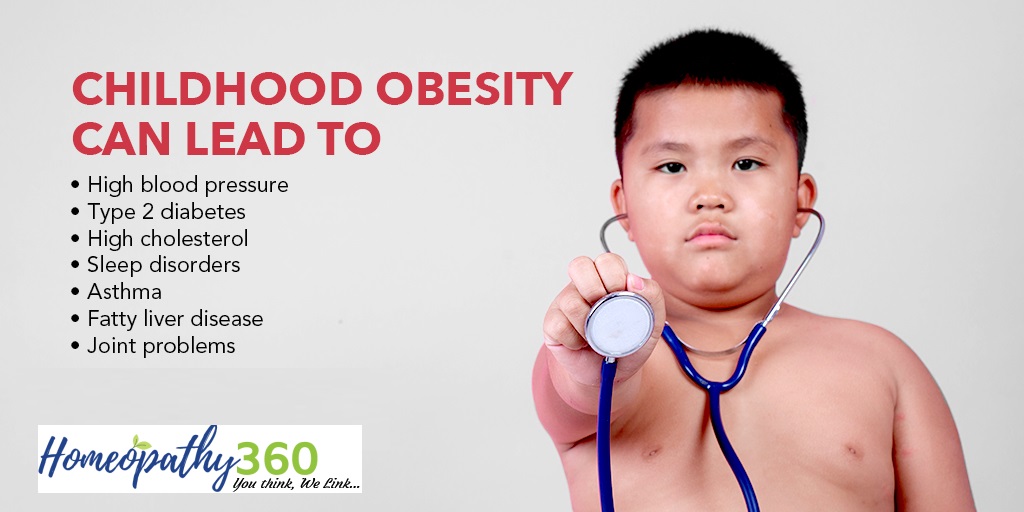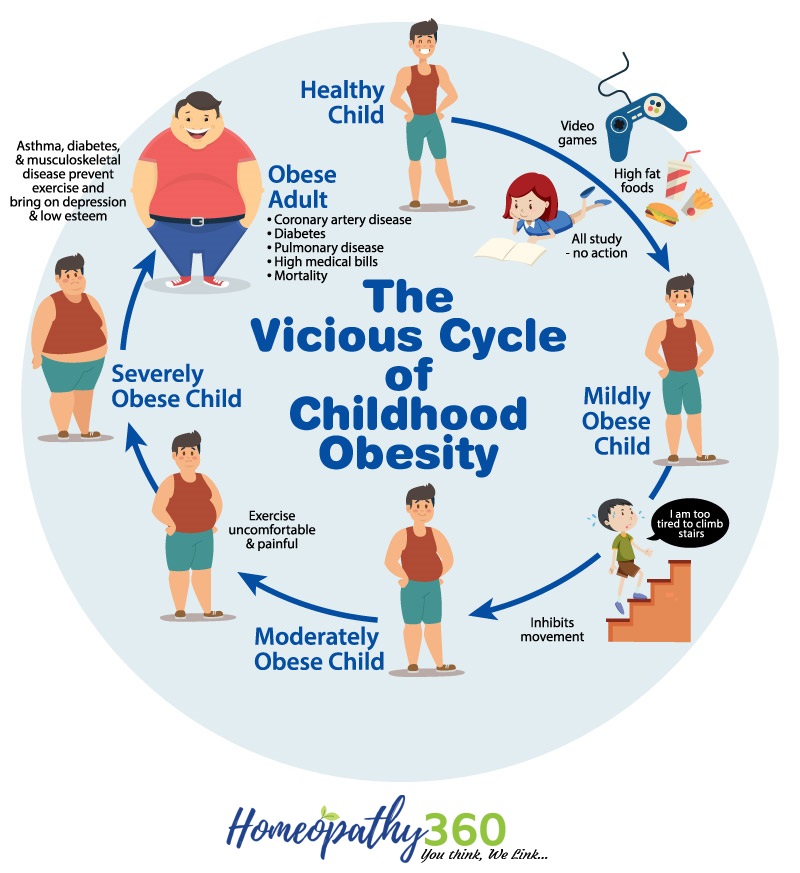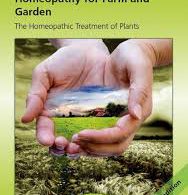
Abstract
Rapid urbanisation and dramatic lifestyle changes in the past few decades have led to the emergence of a silent obesity pandemic, especially among children. Obesity whether due to the genetic soil or the sedentary pattern, or combination of both can negatively affect the development of physical health as well as the mental potential of these children in future. In homoeopathy, constitution is a major tool for selecting remedies which portrays the phenotype resulting from a unique genetic expression of individuals exposed to varying lifestyles and acts as a fertile or sterile ground, on which pathologies develop and thrive. The “similia” between obesity and constitutional tendencies of Calcarea group of remedies for obesity in children has been portrayed through this article.
Keywords: homoeopathy, lifestyle disorders, obesity, obesity in children, sedentary lifestyle, calcarea group, constitution
Abbreviations:
World Health Organization (WHO), body mass index (BMI), standard deviation (SD) , intrauterine growth retardation (IUGR), intrauterine (IU), complementary and alternative medicine (CAM)

Introduction
The World Health Organization (WHO) defines obesity as abnormal or excessive fat accumulation that may impair health1. A crude measure of obesity is the body mass index (BMI). BMI is the ratio of a person’s weight in kilograms and the square of his height in meters (kg/m2)2. A person with a BMI of > 30 is generally considered obese and with BMI > 25 is considered overweight. For children less than 5 years of age, overweight is weight-for-height greater than 2 standard deviations (SD) and obesity is greater than 3 SD above the WHO Child Growth Standards median. For children aged between 5-19 years, overweight is BMI-for-age greater than 1 SD and obesity is greater than 2 SD above the WHO growth reference media3.
According to the WHO, over 40 million children under the age of 5 and 340 million children and adolescents aged 5-19 are overweight or obese3. Obesity can have adverse effect on health of these children, leading to reduced life expectancy and/or can be associated with different types of diseases like type 2 diabetes, dyslipidemias, cardiovascular disease, hypertension and cancer in later life. Obesity is a multifactorial disease that results from the interaction between the environment, culture, physiology, metabolism and genetics. Predisposition to obesity in children can be due to genetics and family history, intrauterine growth retardation (IUGR) with rapid post natal weight gain, excess maternal weight gain, IU exposure to gestational diabetes, formula feed dietary excretions like excess sugar, starches and fried food, sedentary lifestyle, etc. Abundance of nutrition clubbed with sedentary lifestyle, leads to increased storage of energy in fat cells of adipose tissues. This accumulation is driven by genetic endowment of individuals, denoted in homoeopathy as “constitutions”. Today, gene expression profiles are instrumented to guide therapeutic and prognostic management whereby genotyping is used to provide a new means to assess the risk of diseases as well as variations in response to a number of drugs, and physicians are able to better understand the role of certain genes in the causality of obesity4.
A high risk of failure is seen in adopting lifestyle modifications, long-term weight management and also the side effects of medical and surgical treatments available, which often makes many parents to search for complementary and alternative medicine (CAM) for treating obesity in their children and adolescents. Homoeopathy is an alternative systems of medicine where the selection of remedy is based upon the law of similar and theory of individualization by using holistic approach.
Calcarea group and Obesity
Reportorial tracing of obesity, boldly chalks out remedies of Calcarea group, which are suited to persons of plus tissue of minus quality according to their constitution. Calcarea carbonicum pathogenesis shows tendency to early obesity. The activity of the lymph glands is not proportional to the capacity for assimilation; oxidation is imperfect; hence, there is a rapid deposition of fat in cellular tissue, especially about the abdomen; but tissues are imperfectly nourished; though apparently robust, he is really sickly; his plethora is apparent; his blood is watery, and contains too many white corpuscles.” Dr. E. A. Farrington5 .The children from this group tend to be plump, slow and have weak resistance to infections. They are well behaved, but obstinate. The child is usually curious, asking questions about religion etc. Calcareas are intellectual but there is imbalance between the physical and mental sphere. Due to this imbalance and also their lack of stamina, they may become depressed and lose interest in work/studies. This often tends to the development of sedentary habits, and thus may lead to these children gaining excess weight.
Constitution and characteristic features of these remedies to understand the individualisation among the group.
- CALCAREA ARSENICOSA: Calcarea arsenicosa suited to lymphatic, scrofulous, and tuberculous, fat persons. Predominantly chilly medicine, the symptoms being < in cold weather; when out of doors. The child is anxious8, has low mood, desires company and afraid to be alone. Child has desire for warm drinks10.
- CALCAREA CARBONICA: Calcarea carbonica child has leuco-phlegmatic temperament, blond hair, light complexion, blue eyes, and fair skin. Psoric constitutions. Child is pale, weak, timid, easily tired when walking. Disposed to grow fat and obese in childhood and youth6. Children with red face, flabby muscles, who sweat easily and take cold readily. Large heads and abdomens; fontanelles and sutures open; bones soft, develop very slowly. Ailments from diseases arising from defective assimilation; imperfect ossification8. These children are obedient, plays near to his mother for safety and security. Fat, flabby children who are slow both mentally and physically. Very slow to respond to commands, complete their task but are neither competitive nor ambitious. There is no aptitude for art and drawing. Misplaces words and expresses himself wrongly. Dull lethargic children who do not want to play (more of indoor games and avoid risky games like football) would prefer watching rather than playing games. These children are very sensitive to rudeness, criticism, reproaches or being laughed at7. Child is precocious, there is curvature of bones, especially spine and long bones; extremities crooked, deformed; bone irregularly developed. Head sweats profusely while sleeping, wetting pillow far around6.
- CALCAREA FLOURICUM: Calcarea flouricum child eats well yet emaciates7. Calcarea flouricum is one of the most sharp and fast Calcarea with less attachment to home, family and parents. Quickness of comprehension and quick in getting to work, but not purposeful and effective. Acute indigestion from fatigue and brain-fag; much flatulence10.
- CALCAREA IODATA: Calcarea iodata is fast and aggressive Calcarea but fearful 7. It is used for the treatment of scrofulous affections, especially enlarged glands, tonsils, etc. Thyroid enlargements about time of puberty. Flabby children subject to adenoids, croup and colds where secretions are inclined to be profuse and yellow 10. Mentally impatient and restless children. There is anticipation and indolence. They are affectionate, desire consolation but weep easily and have fear of dogs.
5. CALCAREA MURIATICUM: Most of the Calcarea muriaticum cured patients were obese.8 Calcarea muriaticum is greatly attached to the mother and comes very close to Pulsatilla nigricans. They are matured and sensitive. Do not like to travel.7
- CALCAREA PHOSPHORICUM: The Calcarea phosphosphoricum child is generally emaciated instead of fat like the typical Calcarea group child. Calcarea phosphosphoricum corresponds to defective nutrition, whether of childhood, puberty, or of old age. Children who are delicate, tall, thin or scrawny; with dirty brownish skin. Flabby children having cold extremities and sluggish development. Usually the ailments come from over-growth, over-study, disappointed love, and physical exertion8. The child requires constant attention. NEEDS ATTENTION. Older children often overwhelmed by the stresses of school, often present with complaints of school phobias, school headaches or stomach pains. Brain Fag, difficulty in performing intellectual operations6. Feeble minded children9. Consider this remedy for children who are emaciated, unable to stand; slow in learning to walk but flabby abdomen.
- CALCAREA SULPHURICUM: Calcarea sulphuricum child has flabby muscles.9 NEEDS APPRECIATION. The place of security is not school, playground or outside but is home. Indicated for children who like to play in water and don’t want to come out of the swimming pool.
In Aphorism 4, Dr Hahnemann has rightly mentioned, “he is likewise a preserver of health if he knows the things that derange health and cause disease, and how to remove them from persons in health”, this ensue that while understanding the causative factors of a disease one should be familiar with the soil on which the disease is thriving, i.e. the constitution of the sick. As constitution is an expression of genetic structure of a person, it can be used to trace out the most similar remedy in diseases with genetic predisposition as a major underlying cause like obesity. From the above description of Calcarea drugs, we can infer that while most of the drugs under Calcarea group have tendency to obesity and excess weight in children, Calcarea phosphoricum children are generally emaciated instead of fat like the typical Calcarea child, and the Calcarea flourica child has tendency to emaciate despite of eating well. Similarly, Calcarea iodatum and Calcarea flouricum are described to be fast and sharp which is in contrast to the general sluggishness and slowness that prevails in the Calcarea soil.Thus, it is the individual characteristic feature of each case which guides us towards the ‘simillimum’ or the antitype of the remedy and forms the basis of homoeopathic prescription. Also, the concern of homoeopathic management of obesity in children should aim at improvement of obesity-related co-morbid conditions and to reduce the risk of developing co-morbidities in future.
Conclusion: The strength of the ‘law of similar’ and ‘individualisation’ has been highlighted
for managing cases of lifestyle disorders like obesity. The individualised constitutional
homoeopathic medicine addresses the underlying cause and individual susceptibility of the child and aims to
treat not only obesity but to restore
the constitutional and
metabolic tendencies. It is
noteworthy that a homoeopathic constitutional prescription is incomplete
without knowing other underlying, exciting and maintaining causes, the miasm of
subject and the characteristics symptoms as well.
References
- World Health Organization. Obesity: preventing and managing the global epidemic. 2000. http://www.who.int/nutrition/publicati ons/obesity/WHO_TRS_894/en/. Accessed 8 May 2017
- World Health Organization. (2018). Obesity and overweight. Available at: http://www.who.int/mediacentre/facts heets/fs311/en/
- World Health Organization’s – Obesity and overweight Fact sheet. Available from: https://www.who.int/en/news-room/factsheets/detail/obesity-and-overweight. Accessed on, 2020 Apr 3
- KASPER et al. Harrison’s Principles of Internal Medicine; 19th Edition
- BURT W.H., Physiological Materia Medica
- ALLEN H.C, M.D, Keynotes and Characteristics with Comparisons of some of the Leading Remedies of the Materia Medica.
- JAIN, P. B., Essence of Pediatric Materia Medica
- CLARKE J.H, M.D, A Dictionary of Practical Materia Medica
- KENT, J.T., M.D, Lectures on Homoeopathic Materia Medica
- BOERICKE W., Pocket Manual of Homoeopathic Materia Medica with Repertory
About Author:
Dr Jyoti Chhikara, MD (Part II), Department of Materia Medica, Bakson’s Homoeopathic Medical College and Hospital, Greater Noida.
Dr Vasundhara Mehrotra, MD (Part II), Department of Materia Medica, Bakson’s Homoeopathic Medical College and Hospital, Greater Noida.
Dr Priya Garg, MD (Part II), Department of Materia Medica, Bakson’s Homoeopathic Medical College and Hospital, Greater Noida.





